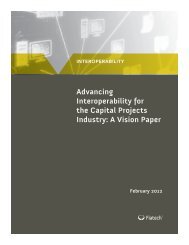An Introduction to ISO 15926 November 2011 - iRINGToday
An Introduction to ISO 15926 November 2011 - iRINGToday
An Introduction to ISO 15926 November 2011 - iRINGToday
You also want an ePaper? Increase the reach of your titles
YUMPU automatically turns print PDFs into web optimized ePapers that Google loves.
CHAPTER 2:<br />
HISTORY OF <strong>ISO</strong> <strong>15926</strong><br />
The ability <strong>to</strong> exchange digital information between computer programs probably became<br />
an issue as soon as the second computer program was written. Software developers create<br />
their applications independently and make individual pragmatic decisions on how <strong>to</strong> represent<br />
data. As a result, users of the software can typically only open a data file by using the authoring<br />
application—not a competi<strong>to</strong>r’s application. In early computing, information exchange<br />
between computer programs could only be done the hard way: by reading the output of one<br />
application and manually rekeying the appropriate parts in<strong>to</strong> another.<br />
Over time, as software vendors responded <strong>to</strong> user’s needs, we have come <strong>to</strong> expect <strong>to</strong> be able<br />
<strong>to</strong> move information from one system <strong>to</strong> another without having <strong>to</strong> completely rekey it. But<br />
we still need <strong>to</strong> know a great deal about the computer systems and work processes involved if<br />
we want the meaning, or semantics, of our information <strong>to</strong> be preserved throughout the exchange.<br />
Today, at the beginning of the second decade of the twenty-first century we are on the verge<br />
of making the vision of open exchange of project information a reality. Although there have<br />
been many business drivers pushing this, it has only become possible via the hard work of<br />
many people and the convergence of the following four areas of study.<br />
• How we use the Internet <strong>to</strong> find information.<br />
• How we know and understand things.<br />
• Open means of s<strong>to</strong>ring and exchanging data.<br />
• The evolution of product information standards.<br />
Figure 2.1 shows how these areas of study relate <strong>to</strong> <strong>ISO</strong> <strong>15926</strong>.<br />
CHAPTER 2<br />
40



